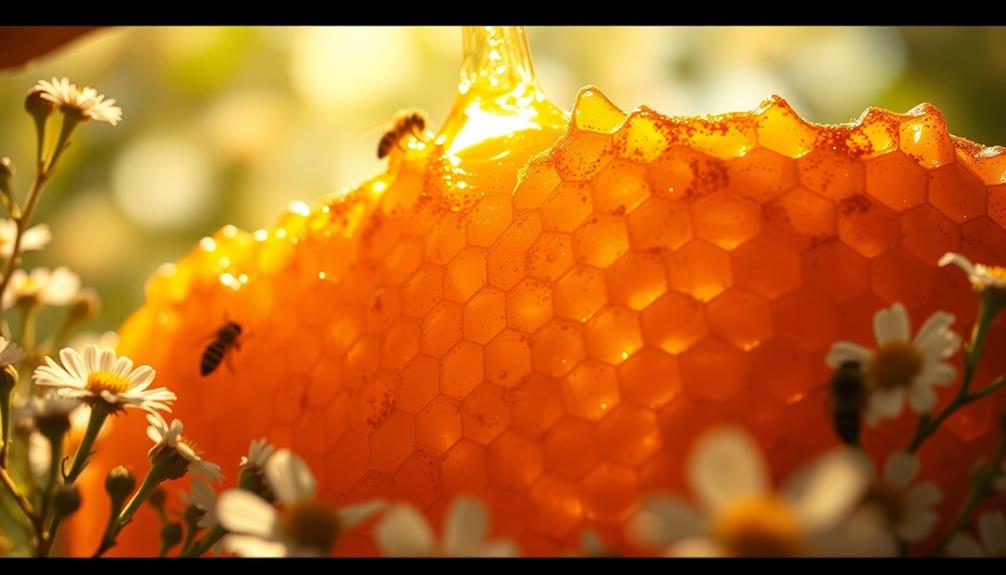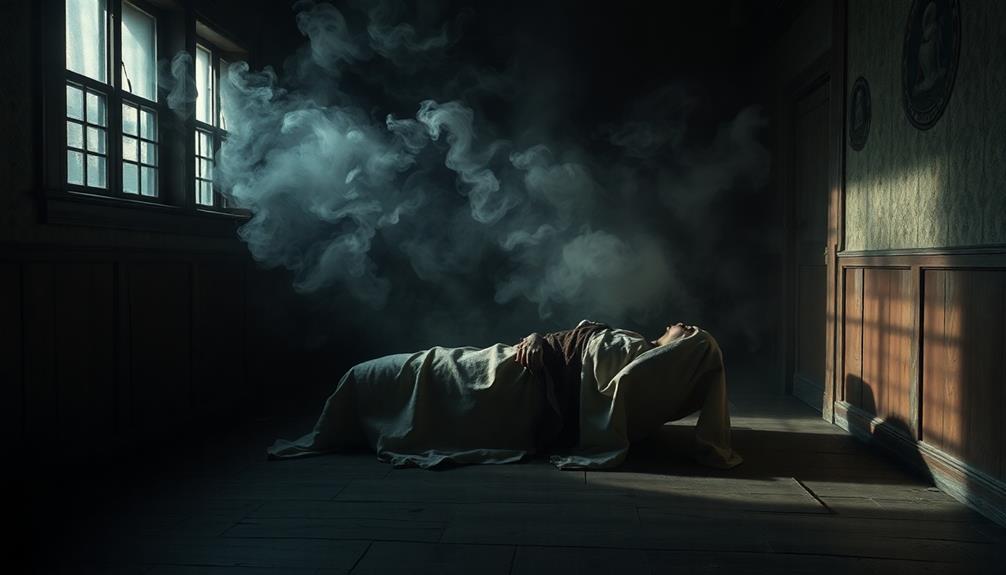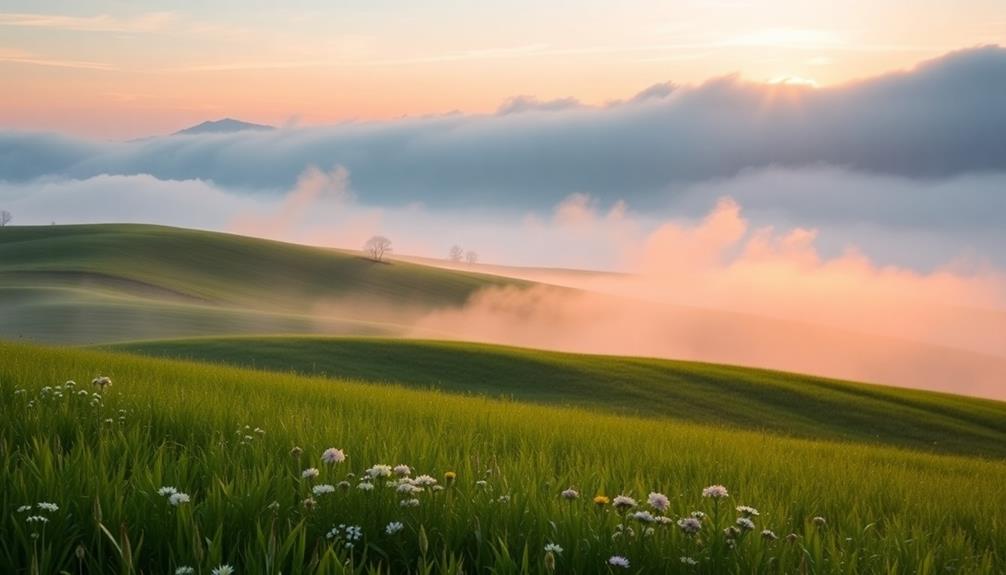Honey smells sweet and floral, but its scent can change based on the flowers visited by bees. For example, eucalyptus honey has a fresh, menthol aroma, while buckwheat honey might remind you of molasses with a stronger scent. Some honey types have notes that can be deep and earthy, while others may be light and fragrant. The local environment and season also play important roles in its aroma. It's fascinating how many factors come together to create honey's unique smell. If you're curious about what influences these differences, there's more to explore!
Key Takeaways
- Honey aroma varies widely, encompassing sweet floral notes to deep earthy scents, influenced by the nectar source and local flora.
- Eucalyptus honey has a fresh, menthol scent, while buckwheat honey may emit a pungent, molasses-like smell.
- The scent of honey can change with age, sometimes resulting in funky odors despite the taste remaining unaffected.
- Seasonal changes and environmental factors significantly impact the aroma, enhancing floral scents during certain times of the year.
- Proper storage is crucial, as high moisture can lead to fermentation, altering the honey's smell and quality.
Introduction

Honey often captivates our senses with its diverse aromas, making it more than just a sweet treat. When you take a whiff of honey, you might notice that honey smells different based on the nectar source bees visited. For instance, if the bees gathered nectar from eucalyptus flowers, you'll enjoy a fresh, menthol aroma.
On the other hand, buckwheat honey can surprise you with its more pungent scent, which might remind you of molasses. You may even encounter unusual smells in honey. Some varieties can have a funky odor, almost like stinky feet! This happens especially with honey made from flowers like goldenrod or aster.
The magic lies in the over 100 volatile organic compounds that create these unique aroma profiles. Also, keep in mind that fermentation can change how honey smells. If honey has high moisture and isn't stored properly, it may develop sour or even alcoholic odors.
Description of the Smell

When you take a closer look at honey's aroma, you'll find it can range widely from sweet and floral to deep and earthy. Depending on the nectar source, honey might smell fresh as grass or even pungent like aged cheese.
For example, honey made from eucalyptus flowers has a strong, distinct scent, while goldenrod can produce odors that remind you of stinky feet!
The types of honey you encounter will greatly influence what you smell. Some varieties are light and delicate, swirling with floral notes, while others can be darker and more robust, carrying hints of earthiness.
It's fascinating how the environment and local flora can change honey's aroma, leading to unique scent profiles in different regions.
Don't forget that age matters, too! Older honey can develop funky odors, even if it still tastes fine.
Also, if honey has high moisture content or hasn't been stored properly, it might emit off-smells due to fermentation.
Source and Composition

Exploring the source and composition of honey reveals how its unique aroma is closely tied to the flowers visited by bees. Honey bees collect nectar from different floral sources, and this nectar becomes the base for honey. The type of flower influences the aroma profiles you smell. For example, eucalyptus flowers give off strong scents, while others may offer milder fragrances.
The magic happens when honey bees transform nectar into honey. This process involves various volatile organic compounds, which are responsible for the distinct smells you notice. There are over 100 different compounds found in honey, making each type smell unique.
Environmental factors play a big role too. Changes in regional flora and seasonal shifts can affect the nectar composition, leading to a range of honey aromas. You might find honey that smells like fresh grass or even pungent aged cheese!
Some types, like buckwheat or thyme honey, can have smells that aren't always pleasant, resembling stinky feet. So, next time you taste honey, remember its aroma tells a story of the flowers and the bees that made it!
Typical Scenarios or Environments

Different scenarios and environments can significantly influence the aroma of honey you encounter. When you think about honey, remember that its scent can change based on where the bees collected nectar.
For example, if the bees visit strongly scented flowers like eucalyptus, the honey can smell very strong and fresh. Honey varieties like Manuka honey are known for their unique scents due to their potent antibacterial properties. On the other hand, honey from local flora such as buckwheat might've an off-putting aroma, resembling pungent aged cheese. This variation in scent can be attributed to the specific plants and compounds found in the nectar the bees collect. For instance, buckwheat honey is often noted for its *hydrogen sulfide odor characteristics*, which can contribute to its strong, somewhat sulfurous aroma. While some people may find this off-putting, others appreciate the bold and distinctive flavor it offers.
The environment and season also play a big role in honey's smell. If it's collected during a time when flowers bloom abundantly, you might notice floral scents. However, honey from plants like goldenrod or aster can have funky smells that some say remind them of stinky feet!
Additionally, as honey ripens and is stored, its aroma can change over time. You may find that some scents become more appealing, while others may not.
Emotional or Cultural Associations
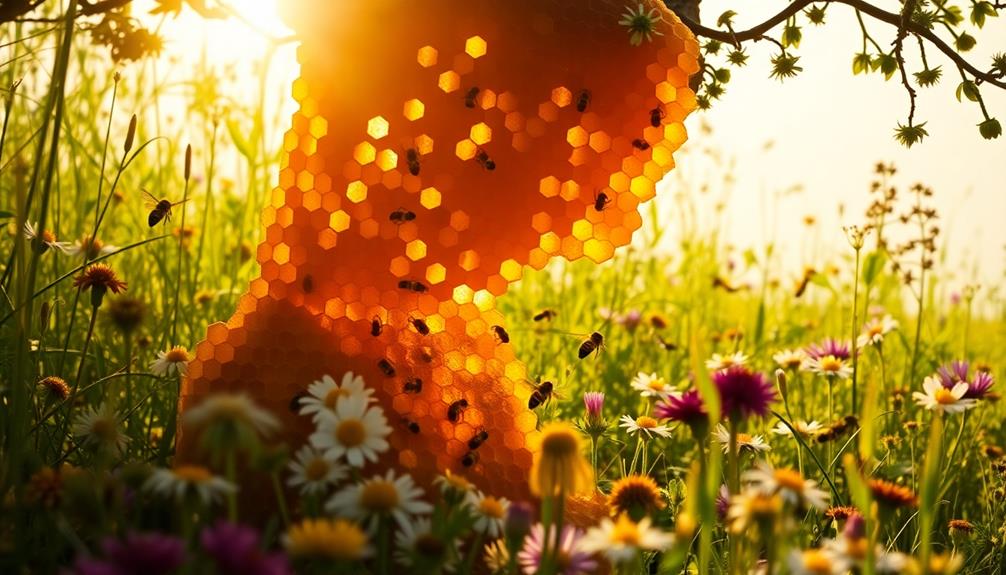
Experiencing the aroma of honey often brings a wave of warmth and comfort, connecting you to sweet memories and cherished moments. The scent of honey isn't just a delightful treat; it's packed with emotional associations. You might remember family gatherings where honey drizzled over warm biscuits filled the air with sweetness.
This aroma can trigger nostalgia, reminding you of fun outdoor adventures or cozy afternoons spent baking.
In many cultures, honey holds special significance. It symbolizes prosperity and happiness, often appearing in traditional rituals. You might see honey used in weddings or during New Year celebrations, where its sweetness signifies a sweet start to the future.
Different floral sources of honey, like lavender or orange blossom, add calming effects, making them popular in aromatherapy for relaxation.
Honey's diverse aroma is also celebrated in various culinary traditions. Each region has recipes that highlight honey, contributing to cultural identity and heritage.
Health or Safety Considerations
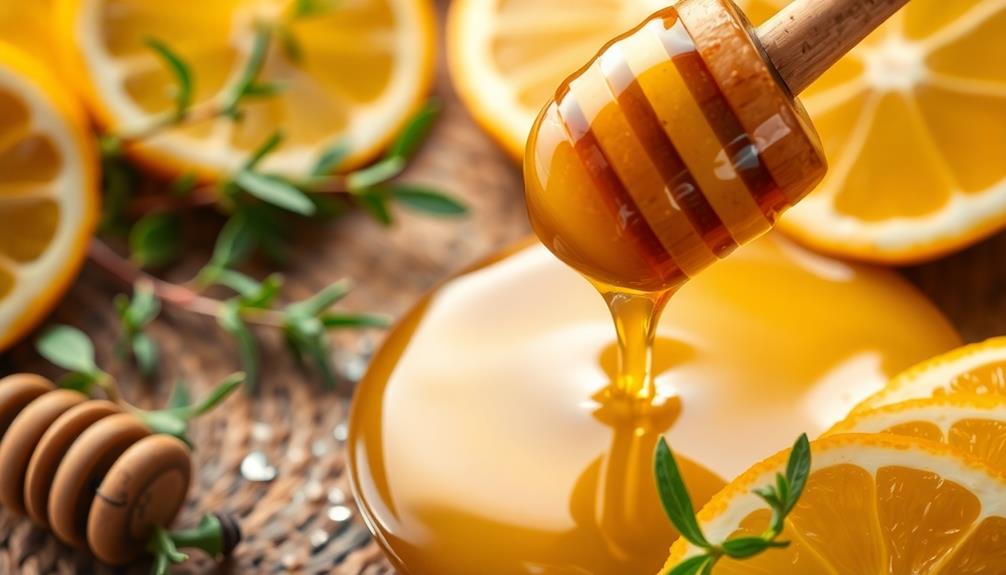
While honey's rich aroma and cultural significance are delightful, it's important to consider its health and safety aspects as well. Honey can spoil if it has a high moisture content, usually over 20%. This moisture can lead to fermentation, where yeast turns sugars into alcohol and acids, causing foul odors and a sour taste.
If you see bubbles or foam, or if honey smells tangy when you open the jar, it's a sign that fermentation has started, which can compromise its safety and quality.
Contamination is another concern. If honey is stored improperly or comes into contact with unsanitary conditions, it may emit foul odors due to harmful microorganisms. Some floral sources, like goldenrod, can also produce honey with unpleasant smells, which could impact its marketability and safety for bees.
To keep your honey fresh and safe, store it in airtight containers, away from moisture and direct sunlight. This simple step can help prevent spoilage and maintain the sweet aroma you love.
Final Thoughts
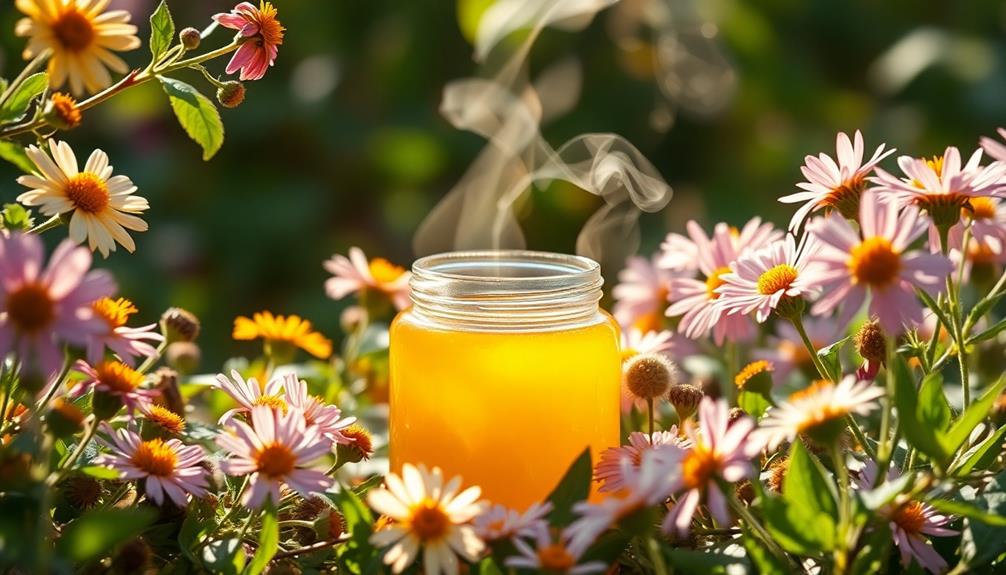
Reflecting on the diverse aromas of honey, it's clear that this sweet substance is more than just a tasty treat; it's a complex sensory experience shaped by various factors.
When you think about how bees collect nectar from different floral sources, it's easy to see why the scent can vary so much. Some honey smells fresh like grass, while others can be dark and funky, resembling aged cheese or even stinky feet!
The unique aroma comes from around 100 volatile organic molecules that mix together. It's fascinating to realize that seasonal changes and local flora can influence the smell of honey over time.
For instance, honey made from strongly scented flowers like eucalyptus has a potent aroma, while less fragrant flowers can lead to off-putting scents.
Frequently Asked Questions
What Does Real Honey Smell Like?
When you smell real honey, you'll notice a delightful blend of floral and fruity notes. Depending on its source, it can range from subtle to strong, with each batch offering a unique aromatic experience. Some varieties even carry hints of herbs or spices, giving them a more complex fragrance. For example, honey from regions where ginger is grown may capture the distinctive scent of ginger, adding a warm, slightly spicy undertone to the sweet bouquet. This natural variability makes each jar of honey a sensory adventure, reflecting its environment and the flowers the bees visited.
What Is the Aroma of Honey?
The aroma of honey varies widely depending on the floral source. You might encounter scents ranging from floral and fruity to smoky or even pungent, each unique and influenced by environmental factors and honey's fermentation process.
Does Honey Smell Nice?
You'll find that honey's smell can be quite pleasing, with floral and fruity notes often dominating. However, some varieties might surprise you with earthy or stronger aromas, which you might not find as appealing.
Why Does My Honey Smell Funny?
If your honey smells funny, it could be due to fermentation from high moisture content or specific flower sources. Storing it properly and monitoring extraction times can help prevent these odor issues in the future.
